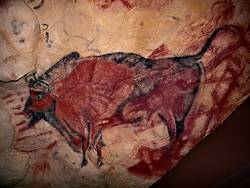Painted Caves


Despite the naive assumption of caves being wet and dripping with water, there are many dry places in natural caves. Dry walls inside caves are very good places for paintings: they are porous or at least coarse, so the colour sticks very good, they are protected against the weather outside, and they have a cool but never freezing climate. Ideal conditions for the conservation of the colour. As a matter of fact we do not know if Stone Age man used only caves for his paintings, he may as well have painted on leather, on rocks, cliff faces and on trees. Unfortunately all those things are destroyed after so many years. We have some areas without caves, where many paintings and engravings can be found on cliffs or rocks. But the most importants artistic remains of our ancestors were found in caves.
Cave paintings can be found all over the world. But the most important and also the oldest paintings have been found in central France and northern Spain. The names Lascaux and Altamira are widely known. There are paintings in the Sahara desert, in South Africa and in the Ural mountains in Russia. There are paintings in northern America and in India. Rather strange is, we do not have a single cave painting in Germany, although we know for sure that it was inhabited at the same time and by the same people as central France. This is a great enigma.
Caves are used for painting and writing until today. There are historic writings which are scientifically explored, like the remains of Wolfgang von Goethe or the Austro-Hungariab naturalist Joseph Anton Nagel. Some tell us about the earliest cave tourism, often with an exact date. And the youngest are generally called graffiti and feared, because they tend to cover and destroy older paintings. There was even a case in southern France were a group of boy scouts cleaned a cave from modern graffiti and accidentally also removed Palaeolithic graffiti.
 Dunhuang Mogao Caves, cn
Dunhuang Mogao Caves, cn Shanjuan Dong, cn
Shanjuan Dong, cn Deutsches Museum, de
Deutsches Museum, de Cueva Pintada, es
Cueva Pintada, es Altamira, es
Altamira, es Cueva de la Pileta - Pileta Cave, es
Cueva de la Pileta - Pileta Cave, es Cueva de Santimamiñe, es
Cueva de Santimamiñe, es Exposition Grotte Chauvet, fr
Exposition Grotte Chauvet, fr Grotte Chauvet, fr
Grotte Chauvet, fr Grotte Cosquer, fr
Grotte Cosquer, fr Grotte de Font-de-Gaume, fr
Grotte de Font-de-Gaume, fr Grotte de Lascaux, fr
Grotte de Lascaux, fr Grotte de Rouffignac, fr
Grotte de Rouffignac, fr Bhimbetka, in
Bhimbetka, in Grotta del Genovese
Grotta del Genovese Damanhur Temple, it
Damanhur Temple, it Fugoppe-dokutsu, jp
Fugoppe-dokutsu, jp Dambulla, lk
Dambulla, lk Dombashawa Rocks and Painted Cave Site, zw
Dombashawa Rocks and Painted Cave Site, zw Shulgan-Tash (Kapova) Cave, ru
Shulgan-Tash (Kapova) Cave, ru Cueva de las Manos, ar
Cueva de las Manos, ar Qala Qala, bo
Qala Qala, bo Pesterna Crkva Sveti Erazmo, mk
Pesterna Crkva Sveti Erazmo, mk The Cave of Swimmers, eg
The Cave of Swimmers, eg Tierradentro Rock Tombs, co
Tierradentro Rock Tombs, co Cueva del Guácharo, ve
Cueva del Guácharo, ve Montelimar Cave, ni
Montelimar Cave, ni Grutas de Lol-Tún, mx
Grutas de Lol-Tún, mx Kain Hitam - The Painted Cave, my
Kain Hitam - The Painted Cave, my Refsvikhula, no
Refsvikhula, no Skaren-Monsen caves, no
Skaren-Monsen caves, no Tatlarin Yeraltı Şehri, tr
Tatlarin Yeraltı Şehri, tr Pictograph Cave, us
Pictograph Cave, us Vasco Caves, us
Vasco Caves, us
 Cave Paintings - Related Books
Cave Paintings - Related Books Search DuckDuckGo for "Painted Caves"
Search DuckDuckGo for "Painted Caves" Paleolithic Cave Paintings
Paleolithic Cave Paintings Archaeologists Are Seeing Cave Art in a New Light - Atlas Obscura (visited: 03-AUG-2021)
Archaeologists Are Seeing Cave Art in a New Light - Atlas Obscura (visited: 03-AUG-2021)
 Index
Index Topics
Topics Hierarchical
Hierarchical Countries
Countries Maps
Maps